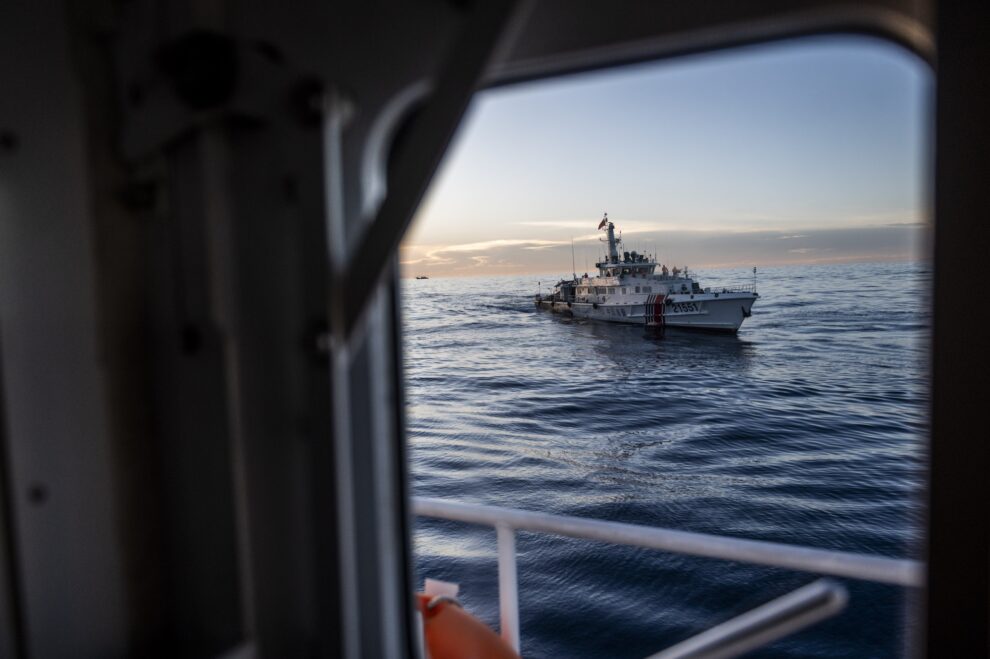Tensions have again flared between the Philippines and China in the South China Sea following incidents last weekend in disputed areas of the Spratly Islands. The Philippines, backed by the US, has accused Chinese coast guard ships on Sunday of blocking its vessels resupplying a small contingent of Philippine troops on the Second Thomas Shoal.
The National Task Force for the West Philippine Sea said Chinese coast guard and maritime militia vessels had “harassed, blocked, and executed dangerous manoeuvres on Philippine civilian supply vessels.” Manila terms the South China Sea as the West Philippine Sea to underscore its territorial claims.
The task force statement claimed that one supply boat had been rammed by a Chinese coast guard ship, and another Chinese vessel had used water cannon against the two supply boats and a Philippine coast guard ship. It also claimed that “severe damage” had been done to one of the supply boats.
The China Coast Guard, however, accused the Philippine boat of disregarding multiple warnings and “deliberately colliding” with the Chinese vessel. It stated that the Philippine boat “changed direction suddenly in an unprofessional, dangerous manner, deliberately colliding with our Coast Guard Vessel 21556.”
The Chinese statement declared that China took “control measures” against the other Philippine supply boat, which was allegedly “carrying construction materials” to the Second Thomas Shoal where the Philippines grounded a World War II warship, the BRP Sierra Madre, in 1999 to stake its claim to the reef. The ship, which is manned by a small military force, appears to be listing to one side.
China insists that the shoal is its territory and claims that the Philippines had agreed to remove the warship from the reef. Philippine President Ferdinand Marcos Jr declared in August that he was not aware of any deal, adding that even if an agreement did exist he was repudiating it.
The Marcos administration, egged on by US imperialism, has adopted a more confrontational approach to China and is aggressively pursuing its territorial claims in the South China Sea. The Philippines mounted another provocative attempt to get supplies to the BRP Sierra Madre in October, when a Chinese and Philippine vessel allegedly collided. The incident created a furore over “Chinese aggression” just before the arrival of Chinese Foreign Minister Wang Yi in Washington for talks about easing tensions with the US.
The incidents on the weekend were far more of an anti-China propaganda exercise than an attempt to resupply or reinforce the BRP Sierra Madre. The head of the Philippine Armed Forces, General Romeo Brawner Jr, was aboard one of the wooden supply boats manned by navy personnel attempting to reach the Second Thomas Shoal.
Brawner denounced the activities of the Chinese vessels to the media in lurid terms. “It’s pure aggression,” he said. “I witnessed how many times the big Chinese coast guard and militia ships cut our path. They water-cannoned us, then bumped us. It’s angering.” While calling for a diplomatic solution, he warned that “the armed forces would continue to support front-line troops and protect fishermen.”
A civilian convoy of about 40 boats organised by the Atin Ito Coalition of Philippine organisations also set out from the island of Palawan on Saturday, claiming to be bringing Christmas cheer to the country’s outposts in the South China Sea. The Coalition, driven by rabid Filipino nationalism, includes the Akbayan Party, a breakaway from the Maoist Communist Party of the Philippines.
In a transparent political stunt, the convoy, which was accompanied by three Philippine Coast Guard ships, turned back to Palawan, claiming that a Chinese vessel had tried to ram one of the boats. Coalition organiser Emman Hizon hailed the convoy as “a success on many levels,” declaring that there would be “many more civilian-led supply missions in the near future.”
The Philippines summoned China’s envoy in Manila on Monday over the weekend confrontations. Foreign ministry spokeswoman Teresita Daza told a news conference that declaring the Chinese ambassador as “persona non grata” was “something that has to be seriously considered” by the government.
On cue, the US ambassador to the Philippines, MaryKay Carlson, declared that the US stood with the Philippines “in vehemently condemning the PRC’s [China’s] repeated illegal and dangerous actions against Philippine vessels.” EU ambassador Luc Veron pronounced Sunday’s incident as “deeply troubling,” while the New Zealand embassy declared that it was “deeply concerned at multiple incidents of dangerous actions towards the Philippines.”
The US State Department also issued a statement condemning China’s actions, hypocritically citing the 2016 international tribunal decision which declared that China had no lawful claims in waters around the Second Thomas Shoal and the Scarborough Reef. That case, drawn up by American lawyers for the Philippines, was based on 1982 Law of the Sea Convention, an international law that the US has never ratified.
Over the past decade, successive US administrations have deliberately inflamed territorial disputes in the South China Sea between China and its neighbours as a means of drawing countries in Southeast Asia behind the escalating US-led war preparations against Beijing throughout the Indo-Pacific. US imperialism regards China, now the world’s second largest economy, as the chief threat to American global dominance.
In what amounts to a threat directed against China, the US State Department reaffirmed that the 1951 US-Philippines mutual defence treaty “extends to armed attacks on Philippine armed forces, public vessels, or aircraft—including those of its Coast Guard—anywhere in the South China Sea.”
In other words, an incident involving Chinese and Philippine vessels could become the pretext for military conflict between the US and China.
Significantly, the rusting hulk—the BRP Sierra Madre—grounded on the Second Thomas Shoal is still an actively commissioned Philippine warship. As such, any “attack” on it could be construed to be an act of war.
The stage is being set for a reckless US-led military operation in league with the Philippines in the name of “resupplying the BRP Sierra Madre.” The US and other American allies, including Australia, have begun joint naval operations in the South China Sea. Last month, the US and Philippine navies conducted a three-day exercise in the seas to the south of Taiwan, another dangerous flash point that Washington has been stoking in its anti-China campaign.
Significantly, the USS Gabrielle Giffords, one of the US Navy’s littoral combat ships, then conducted a provocative “freedom of navigation operation” into waters near the Second Thomas Shoal. The Chinese military’s Southern Theatre Command denounced the exercise as illegal, declaring that it “fully illustrates that the US is the biggest threat to peace and stability in the South China Sea.”
Far more dangerous would be the direct involvement of the US military in an operation in league with the Philippines to reach the BRP Sierra Madre.










